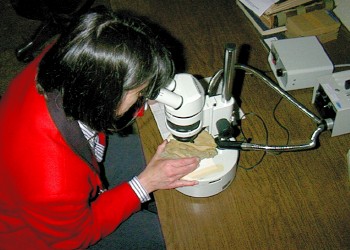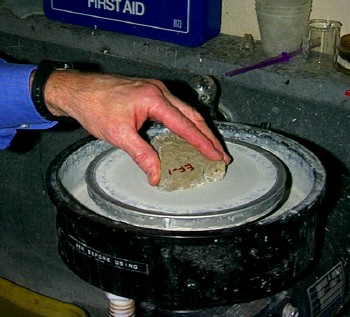 Rodney Watkins using references to identify a fossil.
Rodney Watkins using references to identify a fossil.
In the Museum laboratories, rock samples are processed to gather detailed information about the Silurian reefs. A hand-operated rock splitter is used to break large blocks into smaller pieces. A single large rock specimen may yield hundreds of individual fossils when processed in this manner. As the geologist splits the rock sample, pieces with fossils are saved and sorted into general categories, such as corals, brachiopods, etc. Pieces without fossils are discarded or saved for geochemical analysis. Fossils obtained from samples are further sorted into species which are identified using the scientific literature. Here the geologist compares brachiopod specimens with pictures and descriptions in the Treatise on Invertebrate Paleontology and an 1867 monograph by James Hall. Sorting and identification establish the composition and biodiversity of the reef fauna. Parts of the rock samples are cut into slabs with a large rock saw, and the slabs are then polished on a grinding wheel or glass plate. Polished rock slabs show sizes, orientations, and growth relationships of reef fossils much better than rough, unprepared rock surfaces. These features are examined under the microscope and recorded on data sheets.
Photo Gallery

Paul Mayer using the rock crusher.
© The Field Museum - CC BY-NC

Patricia Burke examining a specimen with a microscope.
© The Field Museum - CC BY-NC

Peter Sheehan polishing a specimen.
© The Field Museum - CC BY-NC

Rodney Watkins using references to identify a fossil.
© The Field Museum - CC BY-NC